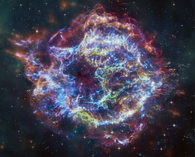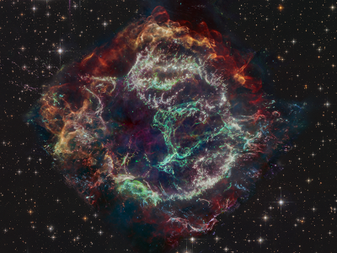The Green Monster hiding in front of Cassiopeia A
(08-01-2024) Ghent University researcher Ilse De Looze led the study on the Green Monster with her DustOrigin team and revealed its true nature: "the Green Monster is photobombing the supernova remnant Cas A rather than being part of it"
When a massive star exploded to create the supernova remnant Cassiopeia A (Cas A) about 340 years ago, it created a ball of matter and light that expanded outward. In the outer parts of Cas A the blast wave is striking surrounding gas that was ejected by the star between about 10,000 and 100,000 years before the explosion and that formed a favorable environment for dust formation after the ejected stellar material cooled down.
“Cas A represents our best opportunity to look at the debris field of an exploded star and run a kind of stellar autopsy to understand what type of star was there beforehand and how that star exploded,” says Danny Milisavljevic of Purdue University in West Lafayette, Indiana, principal investigator of the Webb program
The new Webb images reveal a structure that stretches across the central regions of the remnant and that was dubbed the “Green Monster” due to its obvious green colour. Note that this multi-colour image was created by artificially linking various colours to the emission emitted at different wavelengths, corresponding to light with different energies. Astronomers working on the data have long been puzzled about the origin of the Green Monster emission.
Ilse De Looze (Ghent University) is a co-investigator of the Webb study. She led the specific study on the Green Monster.
“A careful analysis of the chemical composition and velocity structure of the Green Monster has allowed us to reveal its true nature. We concluded that the Green Monster is photobombing the central part of the supernova remnant Cas A rather than being part of it. Instead, the Green Monster corresponds to material that was lost by the star about 10.000-100.000 years before the explosion and that is now swept up by the expanding supernova shock wave” says Ilse De Looze

The Chandra data also show that the material in the Green Monster is all moving towards us, indicating that it is plowing into the star’s ejected gas on the near side of Cas A. Its speed is about half the average speed of the blast wave, suggesting that the density of material in the Green Monster is much higher than the average density of material surrounding Cas A. This result can help reconstruct the complicated history of mass lost by the star before it exploded.
“These Webb survey data and initial findings, supported by other telescopes like Chandra, help address unresolved questions about massive star explosions that have broad implications for the formation and evolution of stellar populations, and the metal and dust enrichment of galaxies,” says Tea Temim of Princeton University, who is a co-investigator of the Webb study
This research has received funding from the European Research Council (ERC) under the European Union’s Horizon 2020 research and innovation programme (Project 'DustOrigin').
Read more?
- A JWST Survey of the Supernova Remnant Cassiopeia A
- X-ray diagnostics of Cassiopeia A’s “Green Monster”: evidence for dense shocked circumstellar plasma
Contact
Ilse De Looze, ilse.delooze@ugent.be
